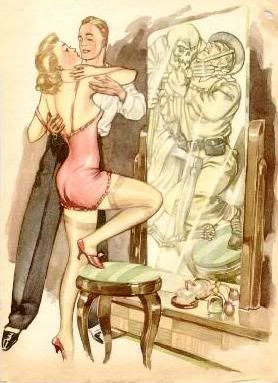
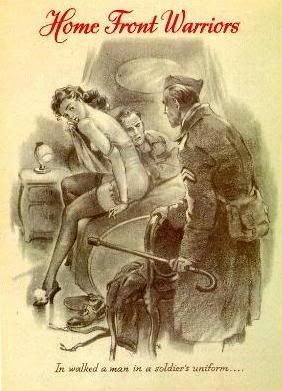
“Psywarrior,” the web site of Herbert A. Friedman, a retired Special Forces officer who is a lecturer on military psychological operations, has an extensive history of the use of sexual imagery in 20th-century war propaganda. (It is somewhat NSFW, but not too dirty.)
Wars are fought mostly by young men, and the persuasive power of kinky pin-ups on a farm boy stuck in a distant trench is something that governments have frequently exploited for their “PSYOPs.” Friedman focuses on World War II, and his most common theme is sex as a weapon against enemy morale, with lots of flyers featuring messages along the lines of “While you’re here fighting like a chump, Johnny, look who’s back home with his paws all over your girl!” I particularly enjoy “Gentlemen prefer blondes ... but blondes don’t like cripples.”
Variations include the injured soldier returning home to find his half-nude Bettie Page look-alike on the lap of some conscientious objector. The Germans tried to appeal to what they considered a latent American anti-Semitism, giving the “home front warriors” names like Sam Levy (barely visible in the picture below right) and dreaded “Jewish” characteristics like glasses, wealth and intelligence. (Guy reading newspaper = traitorous fiend.)
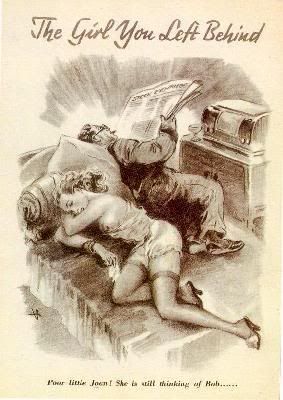
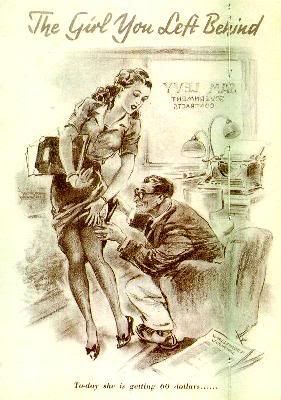
Some of the most morbid of these pictures are actually quite intellectually provocative, for instance the image (at left on the top of this post) of a cheating Betty in her boudoir mirror; in its reflection, poor Johnny succumbs to Death’s embrace. That could be powerful anti-war propaganda for anybody.
Or simple pornography. The women are mannequins from the golden age of the pin-up, and the narrow range of scenarios depicted in these publications — posters, leaflets and the like — reflect the infinitely recyclable dramatic templates of porn. Vivid, salacious detail helps pierce the opponent’s psyche and get him thinking about anything but fighting. So over and over again we see an ecstatic Varga girl in the arms of “that slick fellow, that slacker,” with a caption that, in slightly different context, could be the set-up for an old-fashioned stag film:
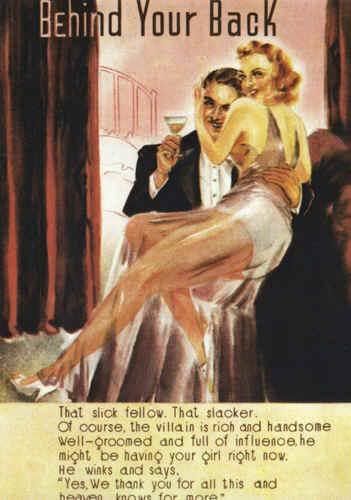
Plain, juvenile vandalism is another topic, with doctored photographs showing Hitler grabbing his erection like a spear or mugging before a pair of naked boobs. And who knew that graphic lesbianism was considered so motivational to G.I.’s!
Korea and Vietnam are covered, though less extensively, and more recent wars get only a cursory look. But is there more to this story in the present day? Does Abu Ghraib figure in? Could it be that in the Internet age, our diet of explicit pornography has so desensitized us that only the most violent and degrading imagery excites our men (and women) in uniform? Or does Abu Ghraib not compare, since the notorious footage there was made for soldiers by soldiers, instead of by foreign spymasters? I’d like to read a broader account of all of this.
Friedman’s conclusion is that sex-themed propaganda never works. Instead of demoralizing the enemy and making him unable to complete his duties, “‘pin-up’ pictures become collectors items and often have the effect of raising morale,” he writes.
He’d certainly know better than I, but he doesn’t give a convincing explanation for the extensive and persistent use of these methods if they were so ineffective. Were they just naive attempts by desk-bound officers and politicians in the primitive early days of PSYOPs? Did they ever work at all? Is there any data on such a thing? If so, it would be fascinating to see.
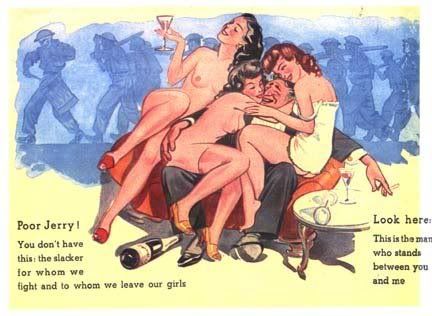


No comments:
Post a Comment